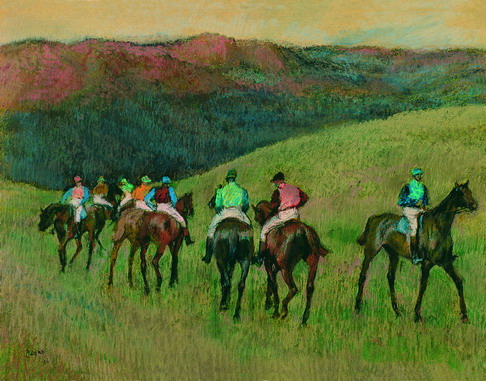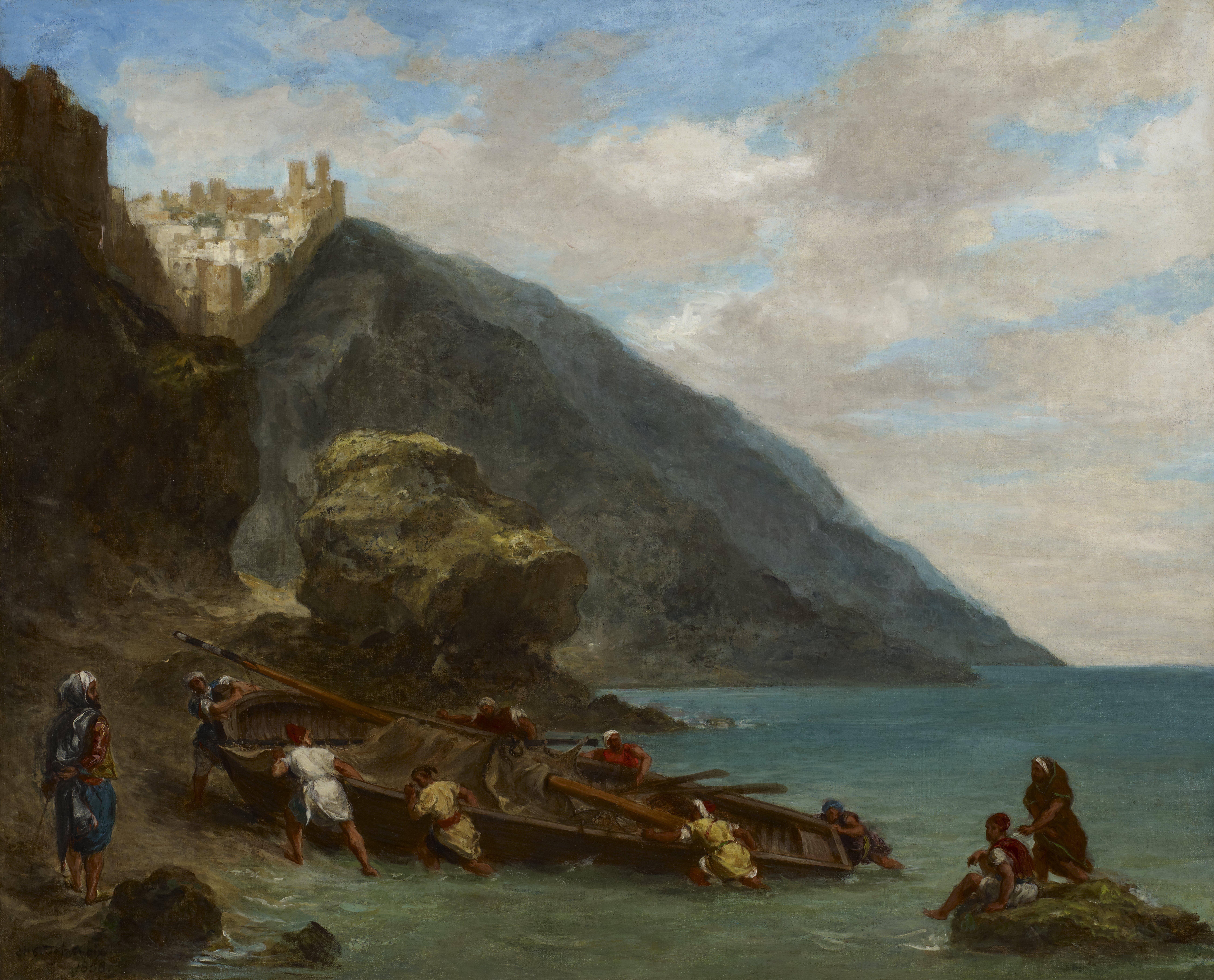INTRODUCTION
Self-portrait 1863
Edgar Degas, Public domain,
via Wikimedia Commons
When most people hear the name Edgar Degas, they picture dancers in rehearsal rooms, milliners bent over hats, women at their toilette, or racehorses in restless motion.
The artist’s association with ballet and the modern life of Paris is so strong that it often eclipses another important, though smaller, dimension of his practice: landscape painting.
While Degas never produced landscapes in the systematic way of Claude Monet or Camille Pissarro, he nonetheless experimented with the genre at several moments in his career.
His landscapes, particularly those made in the 1890s, stand apart as luminous explorations of memory, mood, and color rather than straightforward depictions of nature.
This essay offers a comprehensive narration of Degas’s landscape paintings, focusing on five significant works, while also situating them beside two comparable examples from other artists. We will explore Degas’s color schemes, his choice of subjects, the locations where these works are housed, and the way they have been valued by collectors, museums, and the art market. In the process, we’ll see how even an artist so strongly linked to the bustle of modern Paris managed to capture the solitude and timelessness of the natural world.
Degas and the Turn Toward Landscape
Degas began his career as a draftsman and history painter, absorbing classical training at the École des Beaux-Arts and in Italy. By the 1860s, he joined with the Impressionist circle, although he always remained apart—preferring to call himself a “realist” or “independent.” Unlike Monet, who embraced plein air practice, Degas worked almost exclusively in the studio, relying on sketches, memory, and imagination. This distinction shaped his approach to landscape: he was not concerned with capturing the instantaneous light of an outdoor scene but with reconstructing its emotional resonance.
During the late 19th century, especially the 1890s, Degas produced a series of landscape monotypes and pastels that feel dreamlike, as if half-remembered visions. He sometimes used a technique of printing a monotype—a kind of single-print engraving with ink—and then overlaying it with pastel, creating shimmering, mysterious surfaces. These works are deeply different from Impressionist plein-air canvases; they seem to arise from memory, atmosphere, and the subconscious, foreshadowing Symbolism and even modern abstraction.
Degas’s Color Scheme in Landscapes
In his landscapes, Degas employed a strikingly different palette than in his ballet interiors. His colors are intensely layered, atmospheric, and often otherworldly:
-
Deep violets, indigos, and blues dominate skies and shadowed terrains.
-
Rusty oranges, siennas, and ochres pulse in earth and shoreline scenes, creating warmth that vibrates against cool tones.
-
Acid greens and turquoises shimmer in meadows or trees, used more for emotional punch than natural fidelity.
-
Silvery grays appear in foggy horizons or twilight fields.
-
Pastel overlays give his surfaces a hazy, dreamlike softness, dissolving edges and leaving shapes to hover between abstraction and description.
Unlike Monet’s calibrated color to register fleeting daylight, Degas’s hues are psychological—they evoke moods of isolation, melancholy, or mystery. His landscapes can appear both vibrant and somber, like memories fading yet glowing at the same time.
Five Major Landscape Paintings by Degas
1. Landscape with Rocks (c. 1892)
This work demonstrates Degas’s fascination with geological forms and rough terrain. Painted in monotype with pastel additions, the scene presents a rocky outcrop glowing with orange and red, while the surrounding ground sinks into deep green. The sky is not detailed but suggested by a pale wash. The composition feels monumental, as if the rocks themselves are characters. Degas uses bold strokes, fusing abstraction with geology, and the result is an uncanny scene of nature remembered through emotion rather than sight.

Landscape with Chimney Smoke - Pastel
Edgar Degas, Public domain, via Wikimedia Commons
2. Landscape with Smokestacks (c. 1890)

Edgar Degas, Public domain, via Wikimedia Commons
This piece balances Degas’s interest in modern industry with natural setting. The foreground consists of darkened earth, while beyond rise faint smokestacks sending plumes into a red-and-violet sky.
The entire work blends memory and imagination—perhaps reflecting Degas’s recollections of northern France’s industrial countryside. The palette is dusky and fiery at once, dominated by reds and blacks.
3. Landscape with Trees (c. 1890–92)
This work exemplifies Degas’s reliance on color harmonies. The trees stand almost like silhouettes, their trunks black against a golden-orange sky. The ground is a symphony of rust and green tones, while the sky radiates with a glow reminiscent of sunset. The painting has less descriptive detail than a traditional landscape; instead, it is charged with rhythm and atmosphere, almost like a visual poem.
4. Landscape with Lake (c. 1892)
This monotype with pastel overlays captures a still body of water bordered by rolling hills. The lake glimmers in pale turquoise and silver, while the land is mottled with browns and deep greens. The sky is rendered in soft gray tones that suggest mist or dawn light. The entire scene is infused with silence and calm—rare qualities in Degas’s usually bustling art.
5. Landscape in the Mountains (c. 1890s)
This work emphasizes vertical thrust: dark peaks rise against a turbulent sky. Degas’s use of indigo, violet, and flashes of orange creates a sense of storm and power. The brushwork—or rather, pastel strokes—conveys the energy of geological upheaval. The piece is less pastoral and more sublime, recalling Romantic depictions of nature’s grandeur but filtered through Degas’s memory-driven process.

Race Horses in a Landscape 1894
Edgar Degas, Public domain, via Wikimedia Commons
Degas’s Choice of Subjects in Landscapes

Edgar Degas, Public domain, via Wikimedia Commons
Unlike Monet or Sisley, who painted rivers, gardens, and towns with consistent fidelity, Degas rarely focused on a single identifiable place. Instead, his landscapes are composite visions—part memory, part invention. His subjects include:
-
Rock formations and mountains (symbolic of permanence and strength).
-
Industrial elements (smokestacks, distant factories, recalling the modern intrusion into nature).
-
Lakes and meadows (rendered in soft, dreamy tones).
-
Trees silhouetted against skies (reduced almost to calligraphic symbols).
By working from memory, Degas transformed natural scenes into psychological landscapes. They are less “records of places” than landscapes of mind, infused with personal solitude, aging, and perhaps nostalgia.
Where Degas’s Landscapes Are Displayed Today
Because Degas produced relatively few landscapes compared to his ballet and portrait works, each surviving piece has special prominence in the institutions that own them. His landscapes can be found in:
-
Major Paris museums, where several monotypes and pastels reside.
-
American collections in New York, Boston, and Chicago, which preserve some of his most experimental landscapes.
-
European holdings, including London and Swiss collections, which showcase late works.
Visitors to these museums often find Degas’s landscapes tucked among his more famous dancers, making them feel like hidden treasures waiting to be discovered.
Valuation of Degas’s Landscapes
In the art market, Degas’s landscapes are rare and highly coveted. While his ballerina pastels and sculptures dominate auction headlines, the landscapes hold a special appeal for advanced collectors and museums because they represent his experimental side.
-
Auction records for Degas landscapes have reached millions, especially when works combine monotype and pastel.
-
Smaller sketches or studies still command strong six-figure sums.
-
Provenance plays a major role; landscapes that belonged to Degas’s contemporaries or appeared in early exhibitions are especially valued.
Beyond financial valuation, scholars see these landscapes as vital in understanding the late 19th-century shift from realism toward abstraction. In this sense, their intellectual and cultural worth far surpasses their relative rarity.
Two Similar Landscapes by Other Artists
To better understand Degas’s unique path, it is useful to compare his landscapes with those of two other artists—one Impressionist peer and one earlier Romantic.

Haystacks at sunset
Claude Monet, Public domain, via Wikimedia Commons
1. Claude Monet, Haystacks at Sunset (1891)

Claude Monet, Public domain, via Wikimedia Commons
Monet’s haystack series, with their shifting colors under different light conditions, provide a foil to Degas.
Where Monet worked outdoors to capture ephemeral daylight, Degas worked indoors from memory, creating timeless and dreamlike visions.
Monet’s palette—pure yellows, violets, blues—shares some similarities, but Monet’s colors describe nature’s actuality while Degas’s evoke interior states.
Both artists, however, share a fascination with how color itself can carry emotion.

View of Tangier
Eugène Delacroix, Public domain, via Wikimedia Commons
2. Eugène Delacroix, View of Tangier (1856)

Eugène Delacroix, Public domain, via Wikimedia Commons
Delacroix’s North African landscapes, filled with vibrant contrasts of blue sky and red earth, anticipate Degas’s bold chromaticism.
Delacroix infused landscape with passion and exotic mood rather than strict description, just as Degas later infused his own landscapes with memory and emotion.
This Romantic heritage helps situate Degas not just within Impressionism but within a longer lineage of expressive landscape painting.
Guide to Degas’s Landscapes
-
Edgar Degas landscape paintings are rare but crucial to understanding his versatility.
-
Degas’s color palette in landscapes includes deep violets, oranges, greens, and silvers, layered in pastel.
-
Major works include Landscape with Rocks, Landscape with Smokestacks, Landscape with Trees, Landscape with Lake, and Landscape in the Mountains.
-
Subjects range from geological forms to industrial motifs, often imagined from memory.
-
Where to see Degas landscapes: Paris, New York, Boston, Chicago, and London collections.
-
Value of Degas’s landscapes: Rare at auction, they command millions when sold, prized for their scarcity and experimentation.
-
Comparison with Monet and Delacroix: Monet sought light’s fleeting moments; Delacroix sought passion; Degas fused memory and imaginationConclusion: Degas’s Landscapes as Inner Worlds
Edgar Degas may forever be associated with dancers bending and spinning under studio lights, but his landscapes form a quieter, haunting chapter of his oeuvre. They are not records of nature in the Impressionist sense but visions shaped by memory, color, and solitude. His palette of violets, oranges, and misty greens evokes not just what a place looks like but how it feels to recall it.
Whether we look at Landscape with Rocks glowing like embers, or Landscape with Lake shimmering in silvery quiet, or Landscape with Smokestacks brooding over industrial skies, we find an artist who translated the natural world into an emotional theater of color.
Today, Degas’s landscapes are preserved in major collections, studied as harbingers of abstraction, and valued both financially and culturally for their rarity. Seen beside Monet’s haystacks or Delacroix’s exotic scenes, they reveal how Degas forged his own path: not light observed directly, but landscape remembered, dreamed, and transformed into art’s enduring mystery.